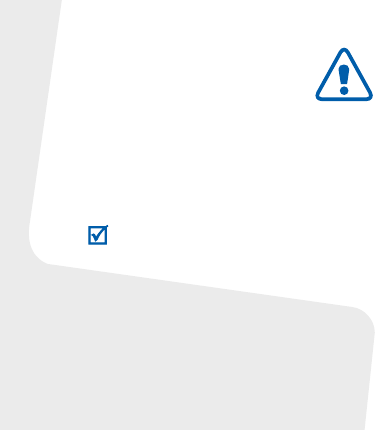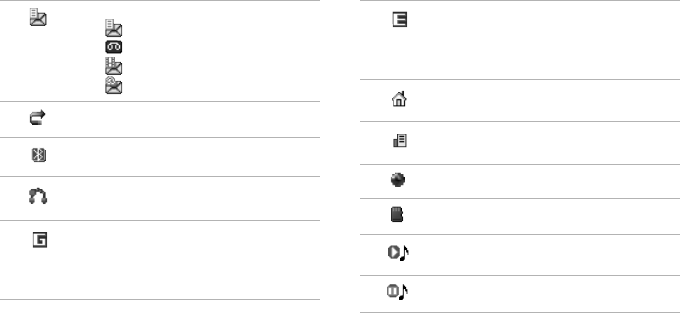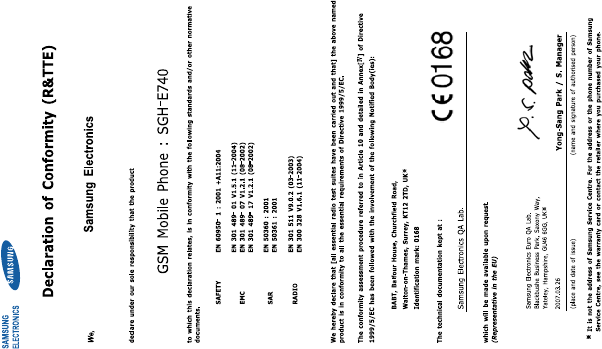Samsung Electronics Co SGHP180 PCS GSM/ EDGE Phone with Bluetooth User Manual
Samsung Electronics Co Ltd PCS GSM/ EDGE Phone with Bluetooth Users Manual
Users Manual

9.User Manual

* Depending on the software installed or your service provider or country, some of the descriptions in this guide
may not match your phone exactly.
* Depending on your country, your phone and accessories may appear different from the illustrations in this
guide.
World Wide Web
http://www.samsungmobile.com
Printed in Korea
Code No.:GH68-XXXXXA
English (EU). 10/2007. Rev. 1.0

SGH-P180
User’s Guide

Copyright information
• Bluetooth
®
is a registered trademark of the
Bluetooth SIG, Inc. worldwide.
•Java
TM
is a trademark or registered trademark
of Sun Microsystems, Inc.
Important safety
precautions
Drive safely at all times
Do not use a hand-held phone while driving. Park
your vehicle first.
Switch off the phone when refuelling
Do not use the phone at a refuelling point (service
station) or near fuels or chemicals.
Switch off in an aircraft
Wireless phones can cause interference. Using
them in an aircraft is both illegal and dangerous.
Switch off the phone near all medical
equipment
Hospitals or health care facilities may be using
equipment that could be sensitive to external radio
frequency energy. Follow any regulations or rules in
force.
Interference
All wireless phones may be subject to interference,
which could affect their performance.
Failure to comply with the following
precautions may be dangerous or illegal.

1
Be aware of special regulations
Meet any special regulations in force in any area
and always switch off your phone whenever it is
forbidden to use it, or when it may cause
interference or danger.
Water resistance
Your phone is not water-resistant. Keep it dry.
Sensible use
Use only in the normal position (held to your ear).
Avoid unnecessary contact with the antenna when
the phone is switched on.
Emergency calls
Key in the emergency number for your present
location, then press .
Keep your phone away from small children
Keep the phone and all its parts, including
accessories, out of the reach of small children.
Accessories and batteries
Use only Samsung-approved batteries and
accessories, such as headsets and PC data cables.
Use of any unauthorised accessories could damage
you or your phone and may be dangerous.
Qualified service
Only qualified service personnel may repair your
phone.
For more detailed safety information, see "Health
and safety information" on page 39.
• The phone could explode if the battery is
replaced with an incorrect type.
• Dispose of used batteries according to the
manufacturer’s instructions.
At very high volumes, prolonged listening
to a headset can damage your hearing.

2
About this Guide
This User’s Guide provides you with condensed
information about how to use your phone.
In this guide, the following instruction icons
appear:
Indicates that you need to pay careful
attention to the subsequent information
regarding safety or phone features.
→
Indicates that you need to press the
Navigation keys to scroll to the specified
option and then select it.
[ ] Indicates a key on the phone.
For example, [ ]
< > Indicates a soft key, whose function is
displays on the phone screen. For
example, <
Menu
>
• Camera and camcorder
Use the camera module on your
phone to take a photo or record
a video.
Special
features of your phone
• Music player
Play music files using your
phone as a music player. You
can use other phone functions
while listening to music.
•FM radio
Listen to your favourite radio
stations anytime, anywhere.

3
• Digital data printing
Print images, messages, and
other personal data directly
from your phone.
•Bluetooth
Transfer media files and
personal data and connect to
other devices using free,
wireless Bluetooth technology.
• Offline mode
Switch your phone to use its
none-wireless functions in an
airplane.
•Name card
Create name cards with your
number and profile. Whenever
introducing yourself to others,
use this convenient electronic
name card.
• Multimedia Message Service
(MMS)
Send and receive MMS
messages with a combination of
text, images, video, and audio.
•Email
Send and receive emails with
image, video, and audio
attachments.
•Java
Enjoy Java™-based embedded
games and download new
games.
• Voice recorder
Record memos or sounds.

4
Contents
Unpack 6
Make sure you have each item
Get started 6
First steps to operating your phone
Power on or off.............................................. 6
Keys and display............................................ 7
Access menu functions .................................. 10
Enter text.................................................... 11
Customise your phone................................... 12
Step outside the phone 14
Begin with call functions, camera, music player, web
browser, and other special features
Make or answer calls..................................... 14
Use the camera ............................................ 16
Play music ................................................... 17
Listen to the FM radio.................................... 19
Browse the web ........................................... 20
Use Phonebook ............................................ 20
Send messages............................................ 21
View messages ............................................ 23
Use Bluetooth .............................................. 24
Menu functions 27
All menu options listed
Health and safety information 39

5
1 Call log
1 Recent contacts
2 Missed calls
3 Dialled calls
4 Received calls
5 Delete all
6 Call time
7 Call costs
1
2 Phonebook
1 Contact list
2 FDN contacts
1
3 Create contact
4 Group
5 Speed dial
6 My namecard
7 Own number
8 Management
9 Service number
1
3 Applications
1 Music player
2 Voice recorder
3 Image editor
3 Applications
(continued)
4 FM radio
5 Bluetooth
6 Java world
7 SIM application toolkit
1
4 Browser
1 Home
2 Bookmarks
3 Enter URL
4 Clear cache
5 Profile settings
6 Current profile
5 Messages
1 Create new message
2 My messages
3 Templates
4 Delete all
5 Settings
6 SOS messages
7 Broadcast messages
8 Memory status
6 My files
1 Images
2 Videos
3 Music
4 Sounds
5 Other files
6 Memory card
2
7 Memory status
7 Calendar
1 Alarm
2 Calendar
3 Memo
4 World clock
5 Calculator
6 Converter
7 Timer
8 Stopwatch
8 Camera
1 Take photo
2 Record video
3 Go to My photos
4 Go to My video clips
9 Settings
1 Time and date
2 Phone settings
3 Display settings
4 Sound settings
5 Light settings
6 Network services
7 Security
8 Memory status
9 Reset settings
10 Key management
11 VOD settings
3
1. Available only if supported
by your SIM card.
2. Available only if a memory
card is inserted into the
phone.
3. Available only if supported
by your service provider.
Overview of menu functions
To access Menu mode, press <
Menu
> in Idle mode.

6
Unpack
Make sure you have each item
• Phone
•Travel Adapter
•Battery
•User’s Guide
You can obtain various accessories from your
local Samsung dealer.
Get started
First steps to operating your phone
Power on or off
The items supplied with your phone and the
accessories available at your Samsung dealer
may vary, depending on your country or service
provider.
Switch on
1. Open the phone.
2. Press and hold [ ].
3. If necessary, enter the
PIN and press <
OK
>.
Switch off
1. Open the phone.
2. Press and hold [ ].

7
Keys and display
Keys
Perform the function indicated on the
bottom line of the display.
In Idle mode, access the following
menus directly:
• Up: My menu mode
• Down/Left/Right: Your favourite
menus
In Menu mode, scroll through menu
options.
In Idle mode, launch the web
browser.
In Menu mode, select the highlighted
menu option or confirm input.
Make or answer a call.
In Idle mode, retrieve numbers
recently dialled, missed, or received.
Delete characters from the display or
items in an application.
Press and hold to switch the phone
on or off.
End a call.
In Menu mode, cancel input and
return the phone to Idle mode.
Enter numbers, letters, and some
special characters.

Get started
8
Icons
The following icons may appear on the top line
of the screen to indicate your phone’s status.
Depending on your country or service provider,
the icons shown on the display may vary.
Enter special characters or perform
special functions.
Adjust the phone volume.
Press to turn on the music player.
In Idle mode, press and hold to turn
on the camera.
In Camera mode, take a photo or
record a video.
Signal strength
Call in progress
Out of your service area or Offline
mode
Alarm set
SOS message feature active

9
New message:
•: Text message
•: Voicemail
• : Multimedia message
•: Email
Call diverting feature active
Bluetooth active
Bluetooth headset or hands-free
car kit connected
GPRS network status
•Blue: GPRS network
• Red: Transferring data in GPRS
network
EDGE network status
•Blue: EDGE network
• Red: Transferring data in EDGE
network
Home Zone
Office Zone
Browsing Internet
Memory card inserted
Music playback in progress
Music playback paused

Get started
10
Access menu functions
FM radio on
Silent mode (Vibration)
Silent mode (Mute)
Ringer type
• None: Melody/Increasing
melody
•: Vibration
• : Melody and vibration/
Increasing and vibration
• : Melody then vibration
• : Vibration then melody
Battery power level
Select an
option
1. Press a desired soft key.
2. Press the Navigation keys to
move to the next or previous
option.
3. Press <
Select
> or [Centre] to
confirm the function displayed
or option highlighted.
4. Press <
Back
> to move up
one level.
Press [ ] to return to Idle
mode.
Use menu
numbers
Press the number key
corresponding to the option you
want.

11
Enter text
Change the
text input
mode
• Press and hold [ ] to switch
between T9 mode ( )
and ABC mode ( ).
• Press [ ] to change case or
switch to Number mode
().
• Press and hold [ ] to switch
to Symbol mode ( ).
ABC mode
To enter a word:
Press the appropriate key until
the character you want appears
on the display.
T9 mode
To enter a word:
1. Press [
2
] to [
9
]
to start
entering a word.
2. Enter the whole word before
editing or deleting
characters.
3. When the word displays
correctly, press [ ] to insert
a space.
Otherwise, press [
0
] to
display alternative word
choices.
Number
mode
Press the keys corresponding
to the digits you want.
Symbol
mode
Press the corresponding
number key to select a symbol.

Get started
12
Customise your phone
Other
operations
• Press [
1
] to enter
punctuation marks or
special characters.
• Press [ ] to insert a space.
• Press the Navigation keys to
move the cursor.
• Press [
C
] to delete
characters one by one.
• Press and hold [
C
] to clear
the entire display.
1. In Idle mode, press
<
Menu
> and select
Settings
→
Phone
settings
→
Language
→
Ringtone
.
2. Select a language.
1. In Idle mode, press
<
Menu
> and select
Settings
→
Sound
settings
→
Incoming call
.
2. Press [Left] or [Right] to
access a ringtone category.
3. Press [Up] or [Down] to
select a ringtone.
4. Press <
Save
>.
Display
language
Call ringer
melody

13
In Idle mode, press [ / ] to
adjust the key tone volume.
1. In Idle mode, press <
Menu
>
and select
Settings
→
Display settings
→
Wallpaper
→
Wallpaper
.
2. Select an image category.
3. Select an image.
4. Press <
Save
>.
1. In Idle mode, press <
Menu
>
and select
Settings
→
Display settings
→
Skin
.
2. Select a colour pattern.
Key tone
volume
Idle mode
wallpaper
Menu mode
skin colour
1. In Idle mode, press
<
Menu
> and select
Settings
→
Phone
settings
→
Shortcuts
.
2. Select a key.
3. Select a menu to be
assigned to the key.
You can switch the phone to
Silent mode to avoid disturbing
other people.
In Idle mode, press and hold
[].
Menu
shortcuts
Silent mode

Step outside the phone
14
Step outside the phone
Begin with call functions, camera, music player,
web browser, and other special features
Make or answer calls
1. In Idle mode, press
<
Menu
> and select
Settings
→
Security
→
Phone lock
.
2. Select
Enable
.
3. Enter a new 4- to 8-digit
password and press <
OK
>.
4. Enter the new password
again and press <
OK
>.
Phone lock
1. Enter an area code and
phone number.
2. Press [ ].
Press [ / ] to adjust the
volume.
3. Press [ ] to end the call.
1. Press [ ] when the phone
rings.
2. Press [ ] to end the call.
Make a call
Answer a
call

15
During a call, press [Centre]
and then <
Yes
> to activate
the speaker.
Press [Centre] again to switch
back to the earpiece.
1. During a call, call the
second participant.
The first call is put on hold.
2. Press <
Options
> and
select
Join
.
3. Repeat step 1 and 2 to add
more participants.
Use the
speakerphone
feature
Make a
multi-party
call
4. During a multi-party call:
•Press <
Options
> and
select
Select one
→
Private
to have a
private conversation with
one participant.
•Press <
Options
> and
select
Select one
→
Remove
to drop one
participant.
5. Press [ ] to end the multi-
party call.

16
Use the camera
1. In Idle mode, press and
hold [ ] to turn on the
camera.
2. Aim the lens at the subject
and make any desired
adjustments.
3. Press [Centre] or [ ] to
take a photo. The photo is
saved automatically.
4. Press <
Back
> to take
another photo.
1. In Idle mode, press [ ]
and select
Go to
My
photos
.
2. Select the photo you want.
Take a
photo
View a
photo
1. In Idle mode, press and
hold [ ] to turn on the
camera.
2. Press [
1
] to switch to
Record mode.
3. Press [Centre] or [ ] to
start recording.
4. Press [Centre] or < > to
stop recording. The video is
saved automatically.
5. Press < > to record
another video.
1. In Idle mode, press [ ]
and select
Go to
My
video
clips
.
2. Select the video you want.
Record a
video
Play a video

17
Play music
Use these methods:
• Download from the wireless
web.
• Download from a computer
using the optional Samsung
PC Studio. See Samsung PC
Studio User’s Guide.
• Receive via Bluetooth.
• Copy to a memory card and
insert it into the phone.
Copy music
files to the
phone
1. In Idle mode, press .
2. Select a playlist
→
a music
file.
3. During playback, use the
following keys:
• Centre: pause or resume
playback.
• Left: return to the
previous file.
• Right: skip to the next
file.
• Up: open the playlist.
• / : adjust the volume.
4. Press [Down] to stop
playback.
Play music
files

Step outside the phone
18
You can create a playlist of
your favourite music on a
memory card.
1. From the music player
screen, select
Playlists
.
2. Press <
Options
> and
select
Create playlist
.
3. Enter the title of the playlist
and press <
Save
>.
4. Select the added playlist.
5. Press <
Options
> and
select
Add
→
a source.
6. Select a playlist
→
a file, or
select the files you want and
press <
Add
>.
7. Press [Centre] to play
music.
Create your
playlist

19
Listen to the FM radio
1. Plug the connecter of the
supplied headset into the
multifunction jack on the
phone.
2. In Idle mode, press
<
Menu
>
and select
Applications
→
FM radio
.
3. Press [Centre] to turn on
the radio.
4. Press [Left] or [Right] to
find available radio stations.
5. Press [Centre] to turn off
the radio.
Listen to the
radio
By automatic tuning:
1. From the radio screen,
press <
Options
> and
select
Self
-
tuning
.
2. Press <
Yes
> to confirm.
Available radio stations are
automatically saved.
By manual setup:
1. From the radio screen,
press [Left] or [Right] to
select the station you want.
2. Press <
Options
> and
select
Add
.
3. Enter the Frequency of the
station and press <
Save
>
to save the station.
Store radio
stations

Step outside the phone
20
Browse the web Use Phonebook
In Idle mode, press [Centre].
The homepage of your service
provider opens.
• To scroll through browser
items, press [Up] or
[Down].
• To select an item, press
< > or [Centre].
• To return to the previous
page, press <
Back
> or [
C
].
• To return to the homepage,
press and hold [
C
].
• To access browser options,
select or press [ ].
• To access other phone
menus, press [ ].
Launch the
web browser
Navigate the
web
1. In Idle mode, enter a phone
number.
2. Press <
Options
> and
select
Save
→
a memory
location
→
New
.
3. For
Phone
, select a number
type.
4. Specify contact information.
5. Press [Centre] or <
Save
>
to save the contact.
1. In Idle mode, press
<
Contacts
>.
2. Enter the first few letters of
the name you want.
Add a
contact
Find a
contact

21
Send messages
3. Select a contact.
4. Scroll to a number and press
[] to dial, or
press
[Centre] to edit contact
information.
1. In Idle mode, press
<
Menu
> and select
Messages
→
Create new
message
→
Text message
.
2. Enter the message text and
press [Centre].
3. Enter destination numbers.
4. Press [Centre] to send the
message.
Send a text
message
1. In Idle mode, press <
Menu
>
and select
Messages
→
Create new message
→
Multimedia message
.
2. Select
Subject
.
3. Enter the message subject
and press [Centre].
4. Select
Image or video
or
Music or Sound
.
5. Select
Add image
or
Add
video
and add an image or a
video clip.
Alternatively, select
Add
music
or
Add sound
and
add a music file or a sound
clip.
6. Select
Text
.
Send a
multimedia
message

Step outside the phone
22
7. Enter the message text and
press [Centre].
8. Press <
Options
> and
select
Send
.
9. Enter destination numbers
or addresses.
10.Press [Centre] to send the
message.
1. In Idle mode, press
<
Menu
> and select
Messages
→
Create new
message
→
Voice
message
.
2. Record your message and
press <
Save
>.
3. Press <
Options
> and
select
Send
.
4. Enter destination numbers
or email addresses.
5. Press [Centre] to send the
message.
Send a voice
message

23
View messages
1. In Idle mode, press
<
Menu
> and select
Messages
→
Create new
message
→
Email
.
2. Select
Subject
.
3. Enter the email subject and
press [Centre].
4. Select
Message
.
5. Enter the email text and
press [Centre].
6. Select
File attach
.
7. Add image, video, sound,
music files, or document
files.
Send an
email
8. Press <
Options
> and select
Send
.Enter email
addresses.
9. Press [Centre] to send the
email.
1. In Idle mode, press
<
Menu
> and select
Messages
→
My
messages
→
Inbox
.
2. Select an text message.
View a text
message

Step outside the phone
24
Use Bluetooth
Your phone is equipped with Bluetooth
technology, enabling you to connect the phone
wirelessly to other Bluetooth devices and
exchange data with them, talk hands-free, or
control the phone remotely.
1. In Idle mode, press
<
Menu
> and select
Messages
→
My
messages
→
Inbox
.
2. Select an multimedia
message.
1. In Idle mode, press
<
Menu
> and select
Messages
→
My
messages
→
Email inbox
.
2. Select
Check new mail
.
3. Select an email or a header.
4. If you selected a header,
press <
Options
> and
select
Retrieve
to view the
body of the email.
View a
multimedia
message
View an
email
1. In Idle mode, press
<
Menu
> and select
Applications
→
Bluetooth
→
Activation
→
On
.
2. Select
My phone’s
visibility
→
On
to allow
other devices to find your
phone.
Turn on
Bluetooth

25
1. In Idle mode, press
<
Menu
>
and select
Applications
→
Bluetooth
→
My devices
→
Search
new device
.
2. Select a device.
3. Enter a Bluetooth PIN or the
other device’s Bluetooth
PIN, if it has one, and press
<
OK
>.
When the owner of the
other device enters the
same code, the pairing is
complete.
Search for
and pair with
a Bluetooth
device
1. Access an application,
Phonebook
,
My files
,
Calendar
, or
Memo
.
2. Select the item you want to
send.
3. Press <
Options
> and
select
Send
via
→
Bluetooth
.
4. For sending a contact,
select which data you want
to send.
5. Search for and select a
device.
6. If necessary, enter the
Bluetooth PIN and press
<
OK
>.
Send data

Step outside the phone
26
1. When a device attempts to
access your phone, press
<
Yes
> to permit the
connection.
2. If necessary, press <
Yes
>
to confirm that you are
willing to receive.
Receive data

27
Menu functions
All menu options listed
This section provides brief explanations of
menu functions on your phone.
Call log Phonebook
Menu Description
Recent contacts,
Missed calls,
Dialled calls,
Received calls
Check the most recent calls
dialled, received, or
missed.
Delete all Delete all of the records in
each call type.
Call time Check the time record for
calls made and received.
Call costs Check the cost of your
calls, if supported by your
SIM card.
Menu Description
Contact list Search for contact
information stored in
Phonebook.
FDN contacts Create a list of contacts to
be used in FDN (Fixed
Dialling Number) mode, in
which the phone allows
outgoing calls only to the
specified phone numbers, if
your SIM card supports this
feature.
Menu Description

Menu functions
28
Applications
Create contact Add a new contact to
Phonebook.
Group Organise your contacts in
caller groups.
Speed dial Assign a speed dial number
for your most frequently
dialled numbers.
My namecard Create a name card and
send it to other people.
Own number Check your phone
numbers, or assign a name
to each of the numbers.
Management Manage contacts in
Phonebook or change the
default settings for
Phonebook.
Menu Description
Service number View the SDN (Service
Dialling Number) list
assigned by your service
provider, if supported by
your SIM card.
Menu Description
Music player Listen to music.
Voice recorder Record voice memos and
any other sounds.
Image editor Edit your photos using
various editing tools.
FM radio Listen to music or news via
the FM radio on your
phone.
Menu Description

29
Browser
Bluetooth Connect the phone
wirelessly to other
Bluetooth devices.
Java world Access Java games and
applications.
SIM application
toolkit Use a variety of additional
services offered by your
service provider. This menu
is available only if
supported by your SIM
card.
Menu Description
Menu Description
Home Connect your phone to the
network and load the
homepage of the wireless
web service provider.
Bookmarks Save URL addresses in
order to quickly access web
pages.
Enter URL Enter a URL address and
access the associated web
page.
Clear cache Clear the cache, which is a
temporary memory site
that stores recently
accessed web pages.

Menu functions
30
Messages
Profile settings Set up connection profiles
for the web browser.
Current profile Select a connection profile
to be used for accessing
the wireless web.
Menu Description
Create new
message Create and send text,
multimedia, voice, or email
messages.
My messages Access messages that you
have received, sent, or that
have failed during sending.
Menu Description
Templates Make and use templates of
frequently used messages
or passages.
Delete all Delete messages in each
message folder all at once.
Settings Set up various options for
using the messaging
services.
SOS messages Specify options for sending
and receiving an SOS
message. You can send an
SOS message by pressing
[Volume] 4 times in Idle
mode, with the phone
closed.
Menu Description

31
My files Planner
Broadcast
messages Change the settings for
receiving broadcast
messages.
Memory status Check the amount of
memory currently in use in
each message folder.
Menu Description
Images, Videos,
Music, Sounds,
Other files
Access media files and
other files stored in the
phone’s memory.
Menu Description
Memory card Access the files stored on a
memory card. This menu is
only available when you
insert a memory card into
the phone.
Memory status Check memory information
for media items.
Menu Description
Alarm Set alarms. The alert type
for a normal alarm
corresponds to the call
alert type setting.
Calendar Keep track of your
schedule.
Menu Description

Menu functions
32
Camera
Memo Make memos for things
that are important and
manage them.
World clock Set your local time zone
and find out the current
time in another part of the
world.
Calculator Perform arithmetic
functions.
Converter Do conversions, such as
length and temperature.
Timer Set a period of time for the
phone to count down.
Stopwatch Measure elapsed time.
Menu Description
Menu Description
Take photo Take photos in various
modes. The camera
produces jpeg photos.
Record video Record a video of what is
displayed on the camera
screen.
Go to My photos Access a list of photos you
have taken.
Go to My video
clips Access a list of videos you
have recorded.

33
Settings
Menu Description
Time and date Change the time and date
displayed on your phone.
Phone settings
→
Language Select a language for the
display text.
Phone settings
→
Greeting
message
Enter the greeting that is
displayed briefly when the
phone is switched on.
Phone settings
→
Slide settings Set how the phone reacts
when you open it for an
incoming call, and when
you close it while using a
function.
Phone settings
→
Shortcuts Use [Down], [Left], and
[Right] as shortcuts to
access specific menus
directly from Idle mode.
Phone settings
→
My menu Set up a menu of your own
using your favourite menu
items, which can be easily
accessed by pressing [Up]
in Idle mode.
Phone settings
→
Advanced
shortcuts
Activate the advanced
shortcut feature, which
allows you to access
specific applications from
the dialling screen.
Phone settings
→
Volume key Set how the phone reacts if
you press and hold [ / ]
when a call comes in.
Menu Description

Menu functions
34
Phone settings
→
USB settings Select a USB mode that will
be used when you connect
your phone to another
device via USB interface.
Phone settings
→
Extra settings Change additional settings
for using the phone.
Phone settings
→
Offline mode Switch the phone to Offline
mode, in which the phone
functions requiring network
connection are deactivated.
Display settings
→
Wallpaper Change the background
image that is displayed in
Idle mode.
Display settings
→
Main menu
style
Select a display style for
the main menu screen.
Menu Description
Display settings
→
Text display Change the display settings
for the text displayed on
the idle screen.
Display settings
→
Skin Select a skin colour pattern
for Menu mode.
Display settings
→
Brightness Adjust the brightness of
the display for varying
lighting conditions.
Display settings
→
Dialling
display
Customise the settings for
the display while dialling.
Display settings
→
Calendar Display the calendar of the
current month on the idle
screen.
Menu Description

35
Display settings
→
Show caller ID Set the phone to display
missed call notifications
with the most recently
missed caller’s information.
Sound settings
→
Incoming call Change the sound settings
for incoming calls.
Sound settings
→
Keypad tone Select the tone that the
phone sounds when you
press a key.
Sound settings
→
Message tone Change the sound settings
for incoming messages
individually according to
message type.
Sound settings
→
Power-on/off
tone
Select the melody that the
phone sounds when it is
switched on or off.
Menu Description
Sound settings
→
Silent mode Set how the phone acts to
alert you to a specific event
while in Silent mode.
Sound settings
→
Extra tones Customise additional tones
for the phone.
Light settings
→
Backlight time Select the length of time
the backlight or display
stays on when the phone is
not used.
Light settings
→
Keypad light Set how the phone controls
the use of the keypad light.
Network
services
→
Call diverting
Set the phone to reroute
incoming calls to a phone
number that you specify.
Menu Description

Menu functions
36
Network
services
→
Call barring
Set the phone to restrict
calls.
Network
services
→
Call waiting
Set the phone to inform
you when someone is
calling you while on
another call.
Network
services
→
Network
selection
Select the network to be
used while roaming outside
of your home area, or let
the network be chosen
automatically.
Network
services
→
Caller ID
Set the phone to hide your
phone number from the
person you are calling.
Menu Description
Network
services
→
Voice mail
server
Store the number of the
voicemail server and
access your voicemails.
Network
services
→
Band selection
Change to an appropriate
band when you travel
abroad.
Security
→
PIN check Activate your PIN to
protect your SIM card
against unauthorised use.
Security
→
Change PIN Change the PIN.
Security
→
Phone lock Activate your phone
password to protect your
phone against
unauthorised use.
Menu Description

37
Security
→
Change
password
Change the phone
password.
Security
→
Privacy Lock access to call logs,
contacts, messages, or
files.
Security
→
SIM lock Set the phone to work only
with the current SIM card
by assigning a SIM lock
password.
Security
→
FDN mode Set the phone to restrict
calls to a limited set of
phone numbers, if
supported by your SIM
card.
Menu Description
Security
→
Change PIN2 Change your current PIN2,
if supported by your SIM
card.
Security
→
Mobile tracker Set the phone to send the
preset tracking message to
your family or friends when
someone tries to use your
phone with another SIM
card.
Memory status Check memory information
for each items in the
phone’s memory or on a
memory card.
Reset settings Reset the phone’s settings
you have changed.
Menu Description

Menu functions
38
Key
management Manage the licence keys
you have acquired to
activate media files locked
by DRM systems.
VOD settings Select a connection profile
to be used for accessing a
video streaming server.
Menu Description

39
Health and safety information
Exposure to Radio Frequency (RF) Signals
Certification Information (SAR)Your wireless phone is a
radio transmitter and receiver. It is designed and
manufactured not to exceed the exposure limits for
radio frequency (RF) energy set by the Federal
Communications Commission (FCC) of the U.S.
government. These FCC exposure limits are derived
from the recommendations of two expert organizations,
the National Counsel on Radiation Protection and
Measurement (NCRP) and the Institute of Electrical and
Electronics Engineers (IEEE). In both cases, the
recommendations were developed by scientific and
engineering experts drawn from industry, government,
and academia after extensive reviews of the scientific
literature related to the biological effects of RF energy.
The exposure limit set by the FCC for wireless mobile
phones employs a unit of measurement known as the
Specific Absorption Rate (SAR). The SAR is a measure
of the rate of absorption of RF energy by the human
body expressed in units of watts per kilogram (W/kg).
The FCC requires wireless phones to comply with a
safety limit of 1.6 watts per kilogram (1.6 W/kg). The
FCC exposure limit incorporates a substantial margin of
safety to give additional protection to the public and to
account for any variations in measurements.SAR tests
are conducted using standard operating positions
accepted by the FCC with the phone transmitting at its
highest certified power level in all tested frequency
bands. Although the SAR is determined at the highest
certified power level, the actual SAR level of the phone
while operating can be well below the maximum value.
This is because the phone is designed to operate at
multiple power levels so as to use only the power
required to reach the network. In general, the closer
you are to a wireless base station antenna, the lower
the power output.
Before a new model phone is available for sale to the
public, it must be tested and certified to the FCC that it
does not exceed the exposure limit established by the
FCC. Tests for each model phone are performed in
positions and locations (e.g. at the ear and worn on the
body) as required by the FCC. The highest SAR values
for this model phone as reported to the FCC are:

Health and safety information
40
; GSM1900 Head: 1.36 W/Kg, Body-worn: 0.332 W/
Kg.For body worn operation, this model phone has been
tested and meets the FCC RF exposure guidelines
whenused with a Samsung accessory designated for
this product or when used with an accessory that
contains no metal and that positions the handset a
minimum of 1.5 cm from the body. Non-compliance
with the above restrictions may result in violation of
FCC RF exposure guidelines.SAR information on this
and other model phones can be viewed on-line at
www.fcc.gov/oet/fccid. This site uses the phone FCC ID
number, A3LSGHP180. Sometimes it may be necessary
to remove the battery pack to find the number. Once
you have the FCC ID number for a particular phone,
follow the instructions on the website and it should
provide values for typical or maximum SAR for a
particular phone. Additional product specific SAR
information can also be obtained at www.fcc.gov/cgb/
sar.
Consumer Information on Wireless Phones
The U.S. Food and Drug Administration (FDA) has
published a series of Questions and Answers for
consumers relating to radio frequency (RF) exposure
from wireless phones. The FDA publication includes the
following information:
What kinds of phones are the subject of
this update?
The term wireless phone refers here to hand-held
wireless phones with built-in antennas, often called
“cell”,”mobile” or ”PCS” phones. These types of wireless
phones can expose the user to measurable radio
frequency energy (RF) because of the short distance
between the phone and the user's head. These RF
exposures are limited by Federal Communications
Commission safety guidelines that were developed with
the advice of FDA and other federal health and safety
agencies. When the phone is located at greater
distances from the user, the exposure to RF is
drastically lower because a person's RF exposure
decreases rapidly with increasing distance from the
source. The so-called °×cordless phones,°± which have
a base unit connected to the telephone wiring in a
house, typically operate at far lower power levels, and
thus produce RF exposures well within the FCC's
compliance limits.
41
Do wireless phones pose a health hazard?
The available scientific evidence does not show that any
health problems are associated with using wireless
phones. There is no proof, however, that wireless
phones are absolutely safe. Wireless phones emit low
levels of radio frequency energy (RF) in the microwave
range while being used. They also emit very low levels
of RF when in the stand-by mode. Whereas high levels
of RF can produce health effects (by heating tissue),
exposure to low level RF that does not produce heating
effects causes no known adverse health effects. Many
studies of low level RF exposures have not found any
biological effects. Some studies have suggested that
some biological effects may occur, but such findings
have not been confirmed by additional research. In
some cases, other researchers have had difficulty in
reproducing those studies, or in determining the
reasons for inconsistent results.
What is FDA's role concerning the safety of
wireless phones?
Under the law, FDA does not review the safety of
radiation-emitting consumer products such as wireless
phones before they can be sold, as it does with new
drugs or medical devices. However, the agency has
authority to take action if wireless phones are shown to
emit radio frequency energy (RF) at a level that is
hazardous to the user. In such a case, FDA could
require the manufacturers of wireless phones to notify
users of the health hazard and to repair, replace or
recall the phones so that the hazard no longer
exists.Although the existing scientific data do not justify
FDA regulatory actions, FDA has urged the wireless
phone industry to take a number of steps, including the
following:
• “Support needed research into possible biological
effects of RF of the type emitted by wireless phones;
• “Design wireless phones in a way that minimizes
any RF exposure to the user that is not necessary
for device function; and
• “Cooperate in providing users of wireless phones
with the best possible information on possible
effects of wireless phone use on human health.

Health and safety information
42
FDA belongs to an interagency working group of the
federal agencies that have responsibility for different
aspects of RF safety to ensure coordinated efforts at the
federal level. The following agencies belong to this
working group:
• “National Institute for Occupational Safety and
Health
• “Environmental Protection Agency
• “Federal Communications Commission
• “Occupational Safety and Health Administration
• “National Telecommunications and Information
Administration
The National Institutes of Health participates in some
interagency working group activities, as well.FDA
shares regulatory responsibilities for wireless phones
with the Federal Communications Commission (FCC).
All phones that are sold in the United States must
comply with FCC safety guidelines that limit RF
exposure. FCC relies on FDA and other health agencies
for safety questions about wireless phones.FCC also
regulates the base stations that the wireless phone
networks rely upon. While these base stations operate
at higher power than do the wireless phones
themselves, the RF exposures that people get from
these base stations are typically thousands of times
lower than those they can get from wireless phones.
Base stations are thus not the primary subject of the
safety questions discussed in this document.
What are the results of the research done
already?
The research done thus far has produced conflicting
results, and many studies have suffered from flaws in
their research methods. Animal experiments
investigating the effects of radio frequency energy (RF)
exposures characteristic of wireless phones have
yielded conflicting results that often cannot be repeated
in other laboratories. A few animal studies, however,
have suggested that low levels of RF could accelerate
the development of cancer in laboratory animals.
However, many of the studies that showed increased
tumor development used animals that had been
genetically engineered or treated with cancer-causing
chemicals so as to be pre-disposed to develop cancer in
absence of RF exposure. Other studies exposed the
43
animals to RF for up to 22 hours per day. These
conditions are not similar to the conditions under which
people use wireless phones, so we don't know with
certainty what the results of such studies mean for
human health.Three large epidemiology studies have
been published since December 2000. Between them,
the studies investigated any possible association
between the use of wireless phones and primary brain
cancer, glioma, meningioma, or acoustic neuroma,
tumors of the brain or salivary gland, leukemia, or other
cancers. None of the studies demonstrated the
existence of any harmful health effects from wireless
phones RF exposures. However, none of the studies can
answer questions about long-term exposures, since the
average period of phone use in these studies was
around three years.
What research is needed to decide
whether RF exposure from wireless
phones poses a health risk?
A combination of laboratory studies and epidemiological
studies of people actually using wireless phones would
provide some of the data that are needed. Lifetime
animal exposure studies could be completed in a few
years. However, very large numbers of animals would
be needed to provide reliable proof of a cancer
promoting effect if one exists. Epidemiological studies
can provide data that is directly applicable to human
populations, but ten or more years' follow-up may be
needed to provide answers about some health effects,
such as cancer. This is because the interval between the
time of exposure to a cancer-causing agent and the
time tumors develop - if they do - may be many, many
years. The interpretation of epidemiological studies is
hampered by difficulties in measuring actual RF
exposure during day-to-day use of wireless phones.
Many factors affect this measurement, such as the
angle at which the phone is held, or which model of
phone is used.
What is FDA doing to find out more about
the possible health effects of wireless
phone RF?

Health and safety information
44
FDA is working with the U.S. National Toxicology
Program and with groups of investigators around the
world to ensure that high priority animal studies are
conducted to address important questions about the
effects of exposure to radio frequency energy (RF).FDA
has been a leading participant in the World Health
Organization international Electromagnetic Fields (EMF)
Project since its inception in 1996. An influential result
of this work has been the development of a detailed
agenda of research needs that has driven the
establishment of new research programs around the
world. The Project has also helped develop a series of
public information documents on EMF issues.FDA and
Cellular Telecommunications & Internet Association
(CTIA) have a formal Cooperative Research and
Development Agreement (CRADA) to do research on
wireless phone safety. FDA provides the scientific
oversight, obtaining input from experts in government,
industry, and academic organizations. CTIA-funded
research is conducted through contracts to independent
investigators. The initial research will include both
laboratory studies and studies of wireless phone users.
The CRADA will also include a broad assessment of
additional research needs in the context of the latest
research developments around the world.
What steps can I take to reduce my
exposure to radio frequency energy from
my wireless phone?
If there is a risk from these products - and at this point
we do not know that there is - it is probably very small.
But if you are concerned about avoiding even potential
risks, you can take a few simple steps to minimize your
exposure to radio frequency energy (RF). Since time is
a key factor in how much exposure a person receives,
reducing the amount of time spent using a wireless
phone will reduce RF exposure.
• “If you must conduct extended conversations by
wireless phone every day, you could place more
distance between your body and the source of the
RF, since the exposure level drops off dramatically
with distance. For example, you could use a headset
and carry the wireless phone away from your body
or use a wireless phone connected to a remote
antenna.
45
Again, the scientific data do not demonstrate that
wireless phones are harmful. But if you are concerned
about the RF exposure from these products, you can
use measures like those described above to reduce your
RF exposure from wireless phone use.
What about children using wireless
phones?
The scientific evidence does not show a danger to users
of wireless phones, including children and teenagers. If
you want to take steps to lower exposure to radio
frequency energy (RF), the measures described above
would apply to children and teenagers using wireless
phones. Reducing the time of wireless phone use and
increasing the distance between the user and the RF
source will reduce RF exposure.Some groups sponsored
by other national governments have advised that
children be discouraged from using wireless phones at
all. For example, the government in the United
Kingdom distributed leaflets containing such a
recommendation in December 2000. They noted that
no evidence exists that using a wireless phone causes
brain tumors or other ill effects. Their recommendation
to limit wireless phone use by children was strictly
precautionary; it was not based on scientific evidence
that any health hazard exists.
Do hands-free kits for wireless phones
reduce risks from exposure to RF
emissions?
• Since there are no known risks from exposure to RF
emissions from wireless phones, there is no reason
to believe that hands-free kits reduce risks. Hands-
free kits can be used with wireless phones for
convenience and comfort. These systems reduce the
absorption of RF energy in the head because the
phone, which is the source of the RF emissions, will
not be placed against the head. On the other hand,
if the phone is mounted against the waist or other
part of the body during use, then that part of the
body will absorb more RF energy. Wireless phones
marketed in the U.S. are required to meet safety
requirements regardless of whether they are used
against the head or against the body. Either
configuration should result in compliance with the
safety limit.

Health and safety information
46
Do wireless phone accessories that claim
to shield the head from RF radiation work?
Since there are no known risks from exposure to RF
emissions from wireless phones, there is no reason to
believe that accessories that claim to shield the head
from those emissions reduce risks. Some products that
claim to shield the user from RF absorption use special
phone cases, while others involve nothing more than a
metallic accessory attached to the phone. Studies have
shown that these products generally do not work as
advertised. Unlike °×hand-free°± kits, these so-called
°×shields°± may interfere with proper operation of the
phone. The phone may be forced to boost its power to
compensate, leading to an increase in RF absorption. In
February 2002, the Federal trade Commission (FTC)
charged two companies that sold devices that claimed
to protect wireless phone users from radiation with
making false and unsubstantiated claims. According to
FTC, these defendants lacked a reasonable basis to
substantiate their claim.
What about wireless phone interference
with medical equipment?
• Radio frequency energy (RF) from wireless phones
can interact with some electronic devices. For this
reason, FDA helped develop a detailed test method
to measure electromagnetic interference (EMI) of
implanted cardiac pacemakers and defibrillators
from wireless telephones. This test method is now
part of a standard sponsored by the Association for
the Advancement of Medical instrumentation
(AAMI). The final draft, a joint effort by FDA,
medical device manufacturers, and many other
groups, was completed in late 2000. This standard
will allow manufacturers to ensure that cardiac
pacemakers and defibrillators are safe from wireless
phone EMI. FDA has tested wireless phones and
helped develop a voluntary standard sponsored by
the Institute of Electrical and Electronic Engineers
(IEEE). This standard specifies test methods and
performance requirements for hearing aids and
wireless phones so that no interference occurs when
a person uses a compatible phone and a compatible
hearing aid at the same time. This standard was
approved by the IEEE in 2000.FDA continues to
monitor the use of wireless phones for possible
interactions with other medical devices. Should
harmful interference be found to occur, FDA will
conduct testing to assess the interference and

47
work to resolve the problem.Additional information on
the safety of RF exposures from various sources can be
obtained from the following organizations:
• FCC RF Safety Program:http://www.fcc.gov/oet/
rfsafety/
• .Environmental Protection Agency (EPA):http://
www.epa.gov/radiation/.
• Occupational Safety and Health Administration's
(OSHA): http://www.osha.gov/SLTC/
radiofrequencyradiation/index.html
• National institute for Occupational Safety and Health
(NIOSH):http://www.cdc.gov/niosh/emfpg.html .
• World health Organization (WHO):http://
www.who.int/peh-emf/.
• International Commission on Non-Ionizing Radiation
Protection:http://www.icnirp.de.
• National Radiation Protection Board (UK):http://
www.nrpb.org.uk.
• Updated 4/3/2002: US food and Drug
Administrationhttp://www.fda.gov/cellphones
Road safety
Your wireless phone gives you the powerful ability to
communicate by voice, almost anywhere, anytime. But
an important responsibility accompanies the benefits of
wireless phones, one that every user must uphold.
When you are driving a car, driving is your first
responsibility. When using your wireless phone while
driving, follow local regulations in the country or region
you are in.
Operating environment
Remember to follow any special regulations in force in
the area you are in, and always switch off your phone
whenever it is forbidden to use it, or when it may cause
interference or danger.°×Federal Communications
Commission
When connecting the phone or any accessory to
another device, read its user’s guide for detailed safety
instructions. Do not connect incompatible products.

Health and safety information
48
As with other mobile radio transmitting equipment,
users are advised that for the satisfactory operation of
the equipment and for the safety of personnel, it is
recommended that the equipment should only be used
in the normal operating position (held to your ear with
the antenna pointing over your shoulder).
Electronic devices
Most modern electronic equipment is shielded from
radio frequency (RF) signals. However, certain
electronic equipment may not be shielded against the
RF signals from your wireless phone. Consult the
manufacturer to discuss alternatives.
Pacemakers
Pacemaker manufacturers recommend that a minimum
distance of 15 cm (6 inches) be maintained between a
wireless phone and a pacemaker to avoid potential
interference with the pacemaker. These
recommendations are consistent with the independent
research and recommendations of Wireless Technology
Research. If you have any reason to suspect that
interference is taking place, switch off your phone
immediately.
Hearing aids
Some digital wireless phones may interfere with some
hearing aids. In the event of such interference, you
may wish to consult your hearing aid manufacturer to
discuss alternatives.
Other medical devices
If you use any other personal medical devices, consult
the manufacturer of your device to determine if it is
adequately shielded from external RF energy.
Your physician may be able to assist you in obtaining
this information.
Switch off your phone in health care facilities when
regulations posted in these areas instruct you to do so.
Vehicles
RF signals may affect improperly installed or
inadequately shielded electronic systems in motor

49
vehicles. Check with the manufacturer or its
representative regarding your vehicle.
You should also consult the manufacturer of any
equipment that has been added to your vehicle.
Posted facilities
Switch off your phone in any facility where posted
notices require you to do so.
Potentially explosive environments
Switch off your phone when in any area with a
potentially explosive atmosphere, and obey all signs
and instructions. Sparks in such areas could cause an
explosion or fire resulting in bodily injury or even death.
Users are advised to switch off the phone while at a
refuelling point (service station). Users are reminded of
the need to observe restrictions on the use of radio
equipment in fuel depots (fuel storage and distribution
areas), chemical plants, or where blasting operations
are in progress.
Areas with a potentially explosive atmosphere are often
but not always clearly marked. They include the areas
below decks on boats, chemical transfer or storage
facilities, vehicles using liquefied petroleum gas, such
as propane or butane, areas where the air contains
chemicals or particles, such as grain, dust or metal
powders, and any other area where you would normally
be advised to turn off your vehicle engine.
Emergency calls
This phone, like any wireless phone, operates using
radio signals, wireless, and landline networks as well as
user-programmed functions, which cannot guarantee
connection in all conditions. Therefore, you should
never rely solely on any wireless phone for essential
communications like medical emergencies.
To make or receive calls, the phone must be switched
on and in a service area with adequate signal strength.
Emergency calls may not be possible on all wireless
phone networks or when certain network services and/
or phone features are in use. Check with local service
providers.

Health and safety information
50
To make an emergency call:
1. Switch on the phone.
2. Key in the emergency number for your present
location. Emergency numbers vary by location.
3. Press
[]
.
Certain features like Call Barring may need to be
deactivated before you can make an emergency call.
Consult this document and your local cellular service
provider.
FCC Notice and Cautions
FCC Notice
. This device complies with Part 15 of the FCC
Rules. Operation is subject to the following two
conditions: (1) this device may not cause
harmful interference, and (2) this device must
accept any interference received, including
interference that may cause undesired
operation.. This equipment has been tested and
found to comply with the limits for a Class B
digital device, pursuant to part 15 of the FCC
Rules. These limits are designed to provide
reasonable protection against harmful
interference in a residential installation. This
equipment generates, uses and can radiate
radio frequency energy and, if not installed and

51
The phone may cause TV or radio interference if used in
close proximity to receiving equipment. The FCC can
require you to stop using the phone if such interference
cannot be eliminated.Vehicles using liquefied petroleum
gas (such as propane or butane) must comply with the
National Fire Protection Standard (NFPA-58). For a copy
of this standard, contact the National Fire Protection
Association, One Battery march Park, Quincy, MA
02269, Attn: Publication Sales Division.
Cautions
Changes or modifications made in the radio phone, not
expressly approved by Samsung, will void the user°Øs
authority to operate the equipment.Only use approved
batteries, antennas and chargers. The use of any
unauthorized accessories may be dangerous and void
the phone warranty if said accessories cause damage or
a defect to the phone.Although your phone is quite
sturdy, it is a complex piece of equipment and can be
broken. Avoid dropping, hitting, bending or sitting on it.
used in accordance with the instructions, may
cause harmful interference to radio
communications. However, there is no
guarantee that interference will not occur in a
particular installation. If this equipment does
cause harmful interference to radio
communications. However, there is no
guarantee that interference will not occur in a
particular installation. If this equipment does
cause harmful interference to radio or television
reception, which can be determined by turning
the equipment off and on, the user is
encouraged to try to correct the interference by
one or more of the following measures:-
Reorient or relocate the receiving antenna. -
Increase the separation between the equipment
and receiver. -Connect the equipment into an
outlet on a circuit different from that to which
the receiver is connected. -Consult the dealer or
an experienced radio/TV technician for help.

Health and safety information
52
Other important safety information
• Only qualified personnel should service the phone or
install the phone in a vehicle. Faulty installation or
service may be dangerous and may invalidate any
warranty applicable to the device.
• Check regularly that all wireless phone equipment in
your vehicle is mounted and operating properly.
• Do not store or carry flammable liquids, gases, or
explosive materials in the same compartment as the
phone, its parts, or accessories.
• For vehicles equipped with an air bag, remember
that an air bag inflates with great force. Do not
place objects, including installed or portable wireless
equipment, in the area over the air bag or in the air
bag deployment area. Improperly installed wireless
equipment could result in serious injury if the air
bag inflates.
• Switch off your phone before boarding an aircraft. It
is dangerous and illegal to use wireless phones in an
aircraft because they can interfere with the
operation of the aircraft.
Failure to observe these instructions may lead to the
suspension or denial of telephone services to the
offender, or legal action, or both.
Care and maintenance
Your phone is a product of superior design and
craftsmanship and should be treated with care. The
suggestions below will help you fulfill any warranty
obligations and allow you to enjoy this product for many
years.
• Keep your phone and all its parts and accessories
out of the reach of small children and pets. They
may accidentally damage these things or choke on
small parts.
• Keep the phone dry. Precipitation, humidity, and
liquids contain minerals that corrode electronic
circuits.
• Do not use the phone with a wet hand. Doing so
may cause an electric shock to you or damage to
the phone.
53
• Do not use or store the phone in dusty, dirty areas,
as its moving parts may be damaged.
• Do not store the phone in hot areas. High
temperatures can shorten the life of electronic
devices, damage batteries, and warp or melt certain
plastics.
• Do not store the phone in cold areas. When the
phone warms up to its normal operating
temperature, moisture can form inside the phone,
which may damage the phone’s electronic circuit
boards.
• Do not drop, knock, or shake the phone. Rough
handling can break internal circuit boards.
• Do not use harsh chemicals, cleaning solvents, or
strong detergents to clean the phone. Wipe it with a
soft cloth.
• Do not paint the phone. Paint can clog the device’s
moving parts and prevent proper operation.
• Do not put the phone in or on heating devices, such
as a microwave oven, stove, or radiator. The phone
may explode when overheated.
• When the phone or battery gets wet, the label
indicating water damage inside the phone changes
colour. In this case, phone repairs are no longer
guaranteed by the manufacturer's warranty, even if
the warranty for your phone has not expired.
• If your phone has a flash or light, do not use it too
close to the eyes of people or animals. This may
cause damage to their eyes.
• Use only the supplied or an approved replacement
antenna. Unauthorised antennas or modified
accessories may damage the phone and violate
regulations governing radio devices.
• If the phone, battery, charger, or any accessory is
not working properly, take it to your nearest
qualified service facility. The personnel there will
assist you, and if necessary, arrange for service.

Health and safety information
54

Position ONLY